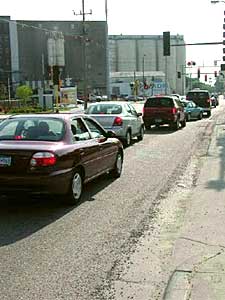|
Audio
Photos
More from MPR
Resources
Your Voice
|
No solution anytime soon to LRT traffic tie-ups
July 18, 2004
Relief could be a long way off for Minneapolis motorists stuck at traffic lights favoring Hiawatha light rail trains. City engineers admit they have few options left to improve traffic tie-ups where roads intersect the tracks. At some intersections south of downtown, drivers waiting to cross LRT tracks are backed-up for as many as four blocks during rush hours. City traffic experts are discussing the possibility of giving cars more right-of-way at the intersections. Metro Transit and state transportation officials, however, say slowing the trains any further violates a federal agreement and risks losing riders.
Minneapolis, Minn. — Looking at a computer screen in the city's traffic control center, transportation design engineer Scott Tacheny can watch in real time how the traffic signal at 46th St. and Hiawatha Ave. is working.
The signal takes two minutes or so to go through a cycle directing cars to stop, go and turn. As a train approaches the intersection, the signal shifts in the middle of a cycle to stop all east-west traffic.
When the trains go by, the traffic signal's cycle is disrupted, changing how it works in relation to the other signals.
 | |||
Much like a police squad car or an ambulance racing to an accident scene, the train is given the power to change traffic lights in its favor along this stretch of the corridor. This ability, known as pre-emption, allows LRT to keep to a schedule and travel the length of the track in about 25 minutes.
But as the train zooms by, cars trying to cross Hiawatha that might have expected a green light in 30 or 40 seconds, now have to wait for the intersection cross arms to go down, the train to pass and the arms to go back up.
Larry Martin is one of the drivers who frequently finds himself stacked behind dozens of other cars on his way to and from work.
"Typically I'll get stuck in a long traffic tie-up that will be several blocks long, waiting to get a handful of cars across the Hiawatha Ave. intersection," Martin said. "It gets particularly problematic if I get stuck behind a school bus or a city bus."
Martin said he sometimes sits 10 or 15 minutes waiting to get through one intersection.
|
What we have out there today is probably as good as it's going to get.
- Minneapolis traffic engineer Dallas Hildebrand |
Since light rail started and the problem became apparent, city engineers have tried several tweaks to move the cars better. City traffic engineer Dallas Hildebrand said staff is running out of options.
"We've attempted various scenarios on movements and timing at the intersection, to try and minimize the impact on traffic as best we can," Hildebrand said. "What we have out there today is probably as good as it's going to get."
At the city's request, the Federal Highway Administration has agreed to send experts to look at the problem to see if it can be fixed. The agency has experience with complex traffic systems. But city officials will also explore down-grading the LRT's pre-emption status. That would require the trains to stop if the traffic signal is red, which is how the trains operate in downtown traffic.
"There really is nothing left for us to try and implement, short of potentially changing the treatment that's afforded to the light rail vehicles as they approach signalized intersections," Hildebrand said.
Any change in the train's relationship to the traffic signals is a major undertaking, and not supported by Metro Transit. Spokesman Bob Gibbons said slowing them down would violate the agreement made when accepting $334 million in light rail funding from the federal government.
"We have a contract with the Federal Transit Administration, and a contract with our customers, to deliver service in the rush hour at seven-and-a-half minute frequency," Gibbons said. "We would be unable to satisfy the federal requirement and the needs of our customers if the trains stopped at the intersections south of downtown."
Gibbons said the pre-emption given to the trains also ensures safety, by closing off the intersections when the trains approach.
LRT is increasingly popular among riders. Metro Transit estimates ridership the second week of operation at 108,000 passengers. That's well above the agency's predicted weekly average of 67,000 riders.
No one is able to keep track of the number of frustrated motorists stuck at intersections -- waiting for the trains to pass.
|
News Headlines
|
Related Subjects
|

